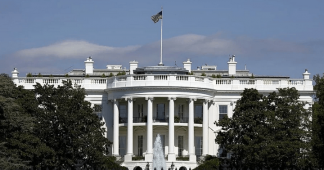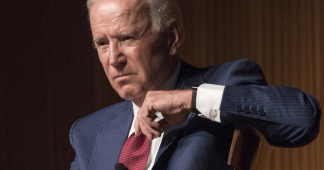Mark Perry
Mar. 5, 2021
It appears that the U.S. military has dodged a bullet. Defense officials reported last week that rather than cut the Pentagon budget, the Biden White House will “flatline” military expenditures, postponing a reset of defense spending priorities.
A senior Pentagon official confirms the report, first headlined in Breaking Defense, telling me that the Biden defense budget (due for release on May 3), will come in at just over $696 billion (total national security outlays, including those to the Department of Energy, could total more than $735 billion), a figure comparable to the base funding provided to the Pentagon in 2021. Put simply, the new Biden administration will keep in place the lavish spending on defense that was a hallmark of the Trump years — a decision likely to spur howls of protest from Biden’s progressive supporters.
The report that Biden’s new defense budget will look a lot like the old defense budget brought sighs of relief to defense hawks who’d spent the last two years prepping for deep cuts in military outlays, reflecting the economic cratering that has accompanied the global pandemic as well as growing unease over the “Trump bump,” which saw defense expenditures rise by $100 billion over three years. “With slim Democratic majorities in the House and Senate and resistance among moderate Democrats to cutting defense significantly, a major reduction in the budget is unlikely,” a Center for Strategic and International Studies paper recently noted.
The senior Pentagon official who spoke with Responsible Statecraft agrees. “If you had asked me just six months ago I would have said that we’re going to have cuts, and maybe even big cuts, in defense spending,” the official said. “But no more. This is all politics. Biden doesn’t want to endanger his domestic agenda, which means he’s not going to pick a fight over defense dollars.”
“This was all decided in the Oval Office,” a former high-profile budget official who is familiar with the Biden budgeting process told us. “I can imagine the meeting: it was Biden, Harris, Ron Klain [Biden’s chief of staff] maybe Susan Rice [the head of the Domestic Policy Council] and Brian Deese [the Director of the National Economic Council] and that’s about it. It’s one of those few times, right at the beginning of a new administration, when the defense budget isn’t decided at the Pentagon. And my bet is that Biden gave the marching orders: ‘doing nothing on defense doesn’t cost us a thing.’ It was probably a pretty short meeting.”
In fact, the White House seems prepared to argue that even modest defense spending cuts undermine the Biden administration’s plans for a post-pandemic economic recovery, as cuts to defense outlays will translate into cuts in defense jobs — a major engine of economic growth. Then too, White House officials (and Biden’s Pentagon team), are poised to argue that any significant budget reductions will have to await a recasting of the Trump administration’s national defense strategy and a Pentagon global posture review, as well as internal assessments on nuclear modernization and navy shipbuilding plans — the Pentagon equivalent of kicking the can down the road.
Finally, the White House is apparently concerned that pushing for defense cuts is likely to peel away crucial support among Senate Republicans and moderate Democrats for Biden’s legislative initiatives on immigration, infrastructure, and climate change. Refusing to reduce defense spending won’t get those votes, but it will keep them in play.
The proposed reprieve on defense cuts hasn’t gone unnoticed among defense hawks, who are prepared to argue that even a flat budget is an obstacle to keeping America secure — a stance previewed at the recent Conservative Political Action Conference, where Biden was skewered for being soft on China.
Defense hawks in Congress are also prepared to argue that even a flat budget does not keep pace with China’s military build-up or with inflation — or with the pro-defense wish list of annual defense increases of three to five percent. Put another way, conservative critics of Biden will likely say that the new administration’s decision not to add to the defense budget actually means a cut in Pentagon spending, an argument the American public will hear in the months ahead. As news of Biden’s likely Pentagon proposal circulated in Washington late last week, senior military officers jumped on the bandwagon, reupping their calls for a larger Navy, full production of the controversial F-35, a follow-on to the F-16 fighter, and more money for the Pacific Deterrence Initiative.
While Biden’s Pentagon budget plans have yet to be fully revealed, anything resembling a proposal that institutionalizes the previous administration’s expenditures will spark controversy among Congressional progressives. This is particularly true for those who were convinced that the military had accepted the economic necessity of making cuts. Joint Chiefs of Staff Chairman Mark Milley said as much back in December, during a teleconference with Michael O’Hanlon, a senior fellow at the Brookings Institute. Milley told O’Hanlon that he not only expected the Pentagon budget “could actually decline significantly,” but that such a decline might be good news.
“That doesn’t mean that the world’s going to end for us,” Milley said. “What that means is that we have to tighten up and take a much harder look at priorities and where we put the moneys we do get.”
Milley doubled down on his views the next day, during a presentation before the Navy Institute: “So, look, I’m an Army guy, and I love the Army…” Milley said, “but the fundamental defense of the United States, and the ability to project power forward [are] going to be naval and air and space power.”
It was a breathtakingly blunt admission that America’s pivot to Asia included a pivot to the Navy, which would now garner a larger share of defense dollars — at the Army’s expense. In fact, Milley’s views had been foreshadowed by a gaggle of respected experts who warned of what Milley admitted would be a budget “bloodletting,” with the Army doing most of the bleeding. But it wasn’t just the Army’s budget that was on the line.
In a now celebrated article, Pentagon reporter David Axe revealed that Air Force Chief of Staff Gen. Charles Q. Brown questioned whether his service should purchase the full complement of 1,763 stealth F-35 fighters, which has not lived up to its billing as “the most lethal, survivable and connected fighter jet in the world.”
In a meeting with reporters, Brown said that he favored designing a new fighter to replace the F-16, a virtual vote of no-confidence in the F-35 (Brown later walked back his comments.) Other services have also questioned the purchases they’ve made over the last years: Navy officers have argued that the Ford class aircraft carrier presents too high a profile in a contest with China, the Marines have already recast their role as America’s primary expeditionary force, and a recent article from the Modern War Institute at West Point recommended that the army reduce its force structure (and save $7 billion), by jettisoning three infantry brigade combat teams.
Now it appears none of that will happen. Rather, after the president rolls out his defense budget in May, the debate inside the Pentagon will not be how to make do with less money, but how to distribute with more than they need. Considering the president’s recent foreign policy moves (airstrikes in Syria, the refusal to act decisively against Mohammed bin Salman, the foot dragging on renewing the JCPOA, and now, his retreat on the defense budget), progressives are questioning whether the man they supported in November is as progressive as they had hoped, or whether (at least on foreign policy and the military) he’s simply Trump without the tweets.
“Progressives are in for a cycle of disappointment,” Gordon Adams, the former Associate Director for National Security Programs at the Office of Management and Budget, says. “But perhaps they shouldn’t be surprised. In some sense this is predictable. What we’re going to see on May 3 is a president who’s focused on domestic issues with a domestic agenda. He’s simply unwilling to endanger that.”
“Joe Biden has to make a decision whether he wants to be a transformational president, or a transactional president,” Lawrence J. Korb, a former assistant secretary of defense, adds. “And I think we’re seeing now what his decision is. That might not be a problem for conservatives and it’s certainly not a problem for the armed services. But it’s a problem for his base. They expected a lot more from him when they pushed that lever.”
In fact, as both Adams and Korb imply, what progressives are facing is unprecedented. This is the first time in American history that the military has signaled that it’s willing to cut its own budget — and the first time in our history that a president has said “no.”
Published at responsiblestatecraft.org











